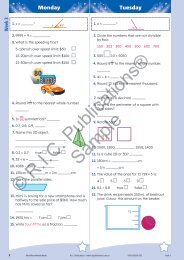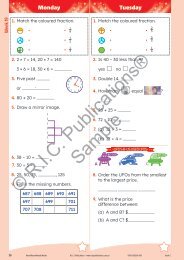RIC-20211 Primary Writing Year 5 – Recounts
You also want an ePaper? Increase the reach of your titles
YUMPU automatically turns print PDFs into web optimized ePapers that Google loves.
<strong>Writing</strong> format information<br />
Explanation<br />
<strong>–</strong> is a framework which outlines how something occurs,<br />
works or is made<br />
<strong>–</strong> includes:<br />
• Title<br />
• Statement: precisely what is to be explained<br />
• Explanation: a clear account in logical sequence of<br />
how and why the phenomenon occurs<br />
• Conclusion: an evaluation and comment about<br />
what has been explained<br />
OR<br />
• Title<br />
• a definition<br />
• a description of the components or parts<br />
• the operation—how it works or is made<br />
• the application—where and when it works or is<br />
applied<br />
• special features—interesting comments<br />
• evaluation or comment/conclusion<br />
<strong>–</strong> uses the following language features:<br />
• subject-specifi c terms and technical vocabulary<br />
where appropriate<br />
• simple present tense is often used<br />
• linking words to show cause and effect<br />
• information is organised into paragraphs<br />
An explanation may be written in the form of an essay, or<br />
a handbook—for example, how a kite works—a science,<br />
health or society and environment text.<br />
Exposition<br />
<strong>–</strong> is a framework which argues for a<br />
particular position and attempts to<br />
persuade the audience to share this<br />
view<br />
<strong>–</strong> includes:<br />
• Title<br />
• Overview: statement of the problem<br />
or issue and the writer’s position<br />
• Arguments: presented in a logical<br />
manner with supporting detail,<br />
usually from the strongest to the<br />
weakest<br />
• Conclusion: a restating of the<br />
writer’s position and a summary of<br />
the arguments presented<br />
<strong>–</strong> uses the following language features:<br />
• a variety of controlling and emotive<br />
words and conjunctions<br />
• paragraphs to state and elaborate on<br />
each point<br />
An exposition may be written in the form<br />
of an essay, a letter, policy statement,<br />
a critical review, an advertisement, an<br />
editorial or a speech.<br />
©R.I.C. Publications<br />
Low Resolution Images<br />
Display Copy<br />
Modelled writing<br />
The role of the teacher is to observe and support students as they develop as writers.<br />
<strong>Writing</strong> is an extremely complex activity, simultaneously involving decisions on content,<br />
text coherence and cohesion, spelling, grammar, punctuation and a sense of audience and<br />
purpose. Because it takes time and practice to develop understanding of the writing process<br />
and the different writing formats, many opportunities for students to interact with their teacher<br />
and their peers are essential.<br />
Modelled writing is an effective way of supporting student writers, particularly when the focus<br />
is on the cognitive processes involved.<br />
Frequent modelling of the planning process and how these plans can be used to write text in<br />
different formats, is strongly recommended.<br />
PRIMARY WRITING<br />
R.I.C. Publications<br />
www.ricgroup.com.au<br />
vii


















